The expert organized his activities on the basis of three essential considerations described below and made proposals concerning the areas in question.
ANY MODIFICATION IN THE MANAGEMENT OF AN ECOSYSTEM INDUCES A MODIFICATION OF THE ECOSYSTEM ITSELF.
CONSEQUENCE: ANY TRIAL FOR THE IMPROVEMENT OF A LAGOONAL ECOSYSTEM REQUIRES PRIMARILY A BASIC KNOWLEDGE OF THE ECOSYSTEM'S ORGANIZATION AND FUNCTIONING.
WHAT ARE THE ORGANIZATION AND FUNCTIONING OF LAGOONAL ECOSYSTEMS?
A seminar was given on the above in Athens (31 July 1987) and in Preveza (3 August 1987) (see also Guelorget and Perthuisot, 1983). A summary follows:
ORGANIZATION AND FUNCTIONING OF A MEDITERRANEAN PARALIC ECOSYSTEM
Most of the paralic ecosystems around the Mediterranean are shallow lagoonal basins. Apart from estuaries, they are of two types:
lagunas which are separated from the open sea by sand bars cut by moving openings, called “graus” in the south of France;
bahiras which are continental depressions invaded by the sea during flandrian eustatic transgression.
Lagunas are usually shallower than bahiras (Guelorget and Perthuisot, 1983; Perthuisot and Guelorget, 1987).
Whereas the tidal amplitude along Mediterranean coasts is feeble, it induces tidal currents through the openings which allow exchanges of water, dissolved elements and suspended matter between the lagoonal systems and the open sea.
The water motions within lagoonal basins are mainly wind-driven, horizontally by coastal drift, and vertically by upwellings (Guelorget et al., 1984).
When the bathymetry is irregular, it sometimes induces stratification of water bodies which can be detected by “clines” (oxyclines, haloclines).
The physical and chemical parameters (temperature, salinity, ion concentrations, etc.) are generally organized in ranges of values whose gradients depend upon two main parameters:
the freshwater balance
the confinement (or restriction with respect to the open sea) which it is possible to define at each point of a paralic basin as the time necessary to renew the medium with sea-originated elements.
The distribution of living organisms in lagoons is zonal, following the confinement gradients from the opening to the farther hydrodynamic reaches of the basins.
This zonal organization is independent of salinity gradients when considering the whole paralic realm. The zonal distribution of macrobenthic species which integrate the variations of the medium allows for the definition of six zones, called confinement zones, from zone I which is the most marine-influenced to zone VI which is the most confined and where biological populations are different depending on the water balance of the basin. This last zone VI is characterized by the presence of blue-green algal mats and/or freshwater species.
Zone III contains the most important populations of suspension-feeders.
From this zonation and the confinement gradients, several quantitative biological patterns appear:
the specific richness (of all biological compartments) decreases with confinement leading from highly diversified populations in zone I to pauci-specific populations in zone VI;
the density increases with confinement;
the macrobenthic and fish biomass is maximum in zone III, whereas the maximum phytoplanktonic biomass occurs in zones IV–V (Figs. 1 and 2).
CONSEQUENCES
There is always in lagoons - especially for the most confined ones - an excess of primary production with regard to the consumption.
Lagoons are generally places of organic matter deposit which induces risks of dystrophy because of the presence of sulphate ions in marine water.
Lagoons transmit phytoplanktonic biomass out to the adjacent open sea and, so doing, enrich it.
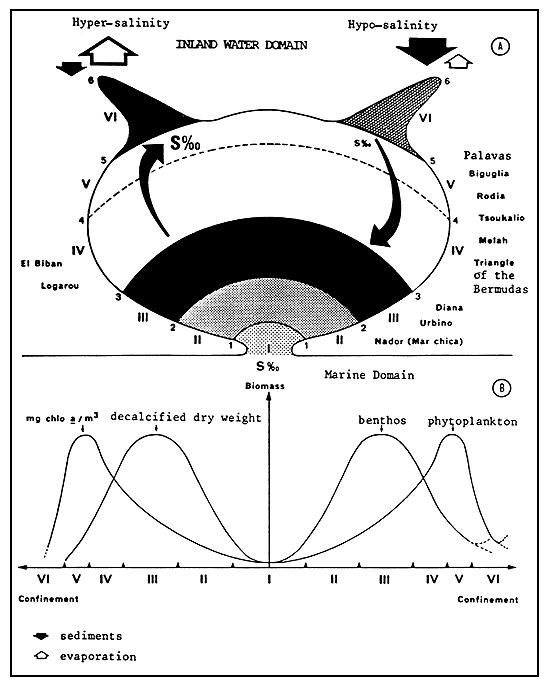
Fig. 1 Biological zones defining the degree of confinement in the Mediterranean model of the paralic ecosystem. Quantities of benthos and phytoplankton in relation to degree of confinement
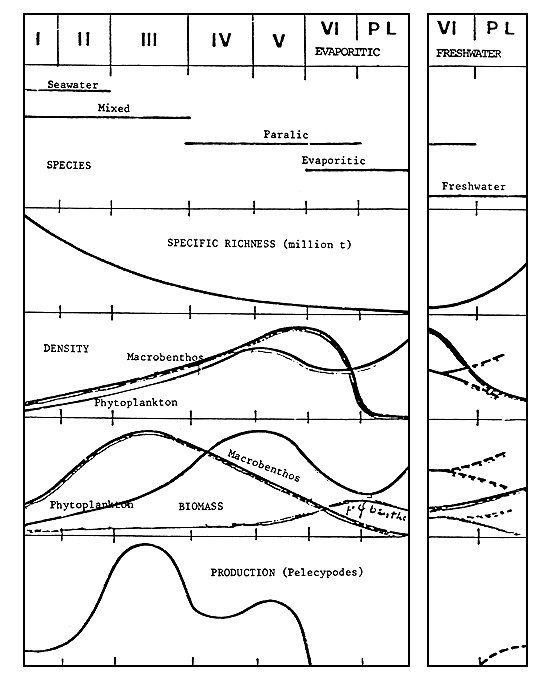
Fig. 2 Specific richness, density, biomass and production in relation to zonation in lagoons
THE MAIN RICHNESS OF LAGOONAL ECOSYSTEMS LIES IN THE MOST CONFINED ZONES WHICH APPARENTLY ARE NOT OF GREAT INTEREST FOR AQUACULTURE. THEY MUST BE PRESERVED AT ALL COSTS.
LAGOONS ARE THE MAIN SOURCE OF RICHNESS FOR ADJACENT MARINE ENVIRONMENTS. EACH REDUCTION OF THE PARALIC REALM IS AN INJURY FOR THE SEA.
PRINCIPLES FOR LAGOONAL MANAGEMENT FOLLOWING ECOLOGICAL PLANIFICATION
ECOLOGICAL PLANIFICATION - METHOD OF CHOOSING SITES FOR AQUACULTURE
Problem
A real problem: the choice of sites adequate for aquaculture
What is “Ecological Planification”?
Ecological, cultural and social inventory
Definition of the aptitudes for different kinds of activities
Synthesis
Choice of the Environmental Descriptors
Principles of choice
Inventory of the main aquaculture techniques
Descriptors evaluation compared with each aquacultural activity
Climatic Descriptors
Synthetic Descriptors
Biological zonation (Fig. 3)
Trophic levels
Pollution
Sensibilities of the environment
Synthesis
Conclusion
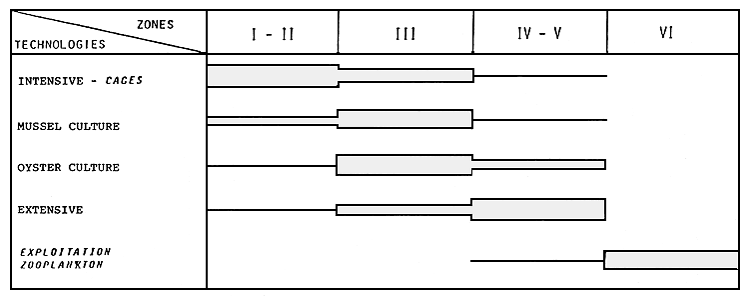
 | : | Strong aptitude |
 | : | Medium aptitude |
| : | Weak aptitude |
Fig. 3 The biological zonation as an indicator for the determination of potentialities in lagoonal ecosystems for different types of aquaculture
SUMMARY
This study presents a methodology of a holistic approach of the “lagoon ecosystems” which aims to identify the potentialities of the environment towards the different types of possible development, such as aquaculture or protection of the site.
Investigations as well as bibliographic research led to the adaptation of the ecological planning methodology in the development of the lagoon environment.
This methodology is applied in three stages:
First Stage:
Ecological inventory of the lagoon. A list of descriptors is established taking into account the whole system complexity.
Second Stage:
Use of the ecological inventory to determine the potentialities of the ecosystem. The different activities taken into consideration-development of aquaculture and protection of the site - are described. Then, every descriptor is interpreted in terms of potentialities for different possible uses.
Third Stage:
By superposition (with or without mapping) of all those elements a composite programme of all activities of the lagoon is tested, taking into account the maximum rate of the ecological potentialities of the environment.
APPLICATIONS OF THESE CONCEPTS TO THE MANAGEMENT OF GREEK LAGOONAL AREAS
A. Messolonghi Lagoonal Area
From previous publications, reports (Klaoudatos et al., 1984; Nicolaidou et al., 1987) and observations of the author in the field during this assignment, the following main characteristics of the Messolonghi lagoonal area (Figs. 4, 5, 6 and 7) can be assessed.
The whole lagoonal area is highly confined with zones IV–V dominating while zone VI is well developed (Fig. 8).
The reasons for this are as follows:
Klissova lagoon
Narrowness of apertures and division of the basin by numerous net barriers.
Etolikon and Messolonghi lagoons
Large freshwater inputs plus presence of a net barrier at the southern edge of Messolonghi lagoon.
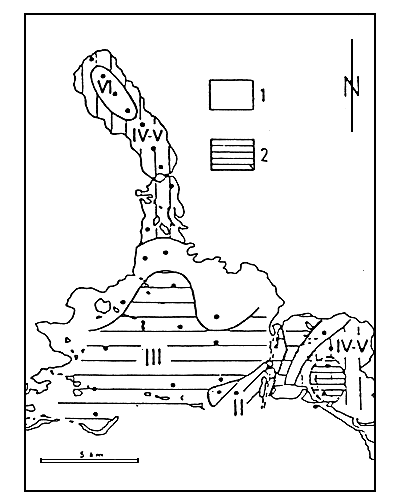
Fig. 8 Map of confinement zones in Messolonghi lagoonal area
Zones II and III (which are the most interesting for aquaculture) are of a feeble extension within the lagoonal system and restricted to the central southern part of Messolonghi lagoon and to the Messolonghi channel.
But it must be stressed that they extend offshore to a width which cannot be determined at the present state of knowledge of the environment.
The Messolonghi lagoonal area produces a high primary biomass (especially the phytoplanktonic biomass) which is partly sedimented as organic matter and partly consumed in the basin itself, partly exported to the Gulf of Patras, which, in this way, is enriched (Fig. 9).
Apart from Aetoliko lagoon, the whole lagoonal area is very shallow, depths never exceeding 1.5 m (in the central part of Messolonghi lagoon).
Because of the high organic matter sedimentation rate and of the high summer temperatures of water, risks of dystrophy are to be feared each year; they induce mortality among the small fish populations if they cannot escape to the sea (which is presently the case).
The present exploitation of the lagoonal system is:
solar salt works
extensive fisheries producing mainly mullets, eels, spars, seabream and seabass, plus occasional species, such as Sardinella.
Fish collecting is mainly done by means of fish traps, which catch even the smaller fish because of the small size of the plastic grids used in the traps.
From these main characteristics of the Messolonghi lagoonal area and from the above considerations on lagoonal management, it is possible to make some recommendations for the aquacultural development of this region.
The whole lagoonal area must be preserved because it is a source of richness for the Gulf of Patras.
Any implementation such as levers, dams, etc., which may restrict the water exchanges between the lagoonal area and the Gulf of Patras are to be avoided.
From the biogeological characteristics of the area, it is impossible to consider anything other than extensive aquaculture in the lagoons, but it seems possible to improve present production. It is proposed to build fish traps which only catch fishes of commercial size, while the small fishes and fingerlings could be kept in near-sea zones, where they could escape the dystrophic crisis. Such a system has to be experimented (Fig. 10).

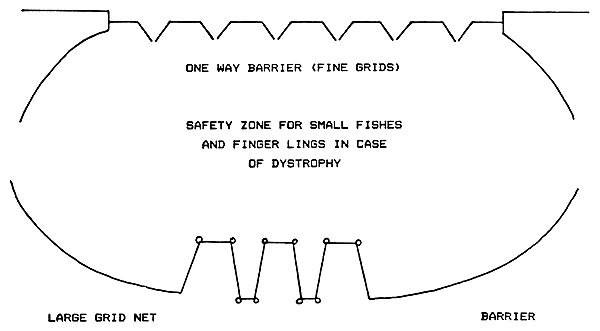
TWO WAYS TRAP (LARGE GRIDS)
In order to catch fishes of commercial size
L A G O O N
POSSIBLE DYSTROPHY OCCURRING
Fig. 10 Principle for extensive aquaculture improvement of Messolonghi area
The most promising zone for aquaculture development in the Messolonghi area is the offshore zone which is suitable for interesting species and benefits from the primary production of the whole system.
This offshore zone is thus proposed for the development of:
enclosures for shrimps
suspended mussels and clams
suspended oysters (flat)
This implies a need for knowledge on:
the bathymetry of the whole possible area
the extension of outflowing phytoplanktonic patch on this area (biomass measurements)
the roughness of the sea in order to confront technological problems (suspended conchyliculture, resistance of enclosures to waves, etc.)
B. Amvrakikos Bay and Related Lagoons
From previous studies (cf. Appendix to this report), it is possible to summarize the main characteristics of this area as follows:
Amvrakikos Bay must be considered as a bahira considering that the pass is fixed and the depth of the basin reaches 60 m.
At several points along its coasts are situated shallow lagunas with moving openings especially in the region around Salaora within the Louros and Arachthos delta.
As far as confinement is concerned, it is obvious that the bay itself is little confined and stays for its main part in zone II, zone III being restricted to the neighbouring lagoons. Meanwhile, it seems that the deepest part of the bay (central part) is occupied by a highly confined, oxygen-depleted water body because of water stratification.
Most of the strictly lagoonal areas, such as Tsoukalio, Rhodia and Logarou are highly confined and stay in zones IV–V and VI mainly because of inland freshwater supplies.
The main aquacultural management activity is extensive fisheries with fish traps and nets which mainly catch:
mullets
eels
a few seabream and seabass
From the above considerations and the biological potentialities of the area it is proposed to develop:
In the first stage, semi-intensive aquaculture (shrimps and clams) in enclosures in the offshore part of lagoons and suspended conchyliculture (mussels and flat oysters).
This requires a better knowledge of the main features of possible zones, and in particular:
bathymetry
shelter
currents
phytoplanktonic biomass maps to be drawn seasonally
In the second stage (and at properly known and suitable sites in the bay), fish cages for seabream and seabass. It is highly recommendable to have a constant survey (monitoring of the whole area when developing each stage (see First Law).
C. Kyparissi Lagoonal Area
The lagoon of Kyparissi consists of two paralic basins, divided by an artificial dam between the island of Gaidaros and the mainland coast.
The Vourlia lagoon, in the northern part of the bay, has a small opening to the sea and Almyros bay, in the southern part, with a large opening to the sea.
According to previous studies (Zenetos and Bei, 1987) and to the author's observations during his assignment, the following emerges:
1. Vourlia lagoonal area
This area is very shallow, with maximum depth 2 m in the central part of the lagoon. The northern part of the lagoon remains uncovered by seawater during low tide. Seawater circulation is provided by the two channels which cut a sand bar located at the entrance of the lagoonal system (Fig. 11). Tide is the most important hydrodynamic factor in the basin. The difference of water level between low and high tides is about 80 cm.
This lagoonal ecosystem is well renewed by seawater. This can be seen by muddy sand sediment without much organic matter and presence of Cymodocea nodosa seagrass throughout the central part of the basin.
The analysis of phytoplanktonic and benthic macrofauna data (Zenetos and Bei, 1987) classifies this lagoon in zone III, in the scale of confinement. Only the northern parts are in zones IV–V and the upper level of the basin in zone VI (presence of blue-green algal mats).
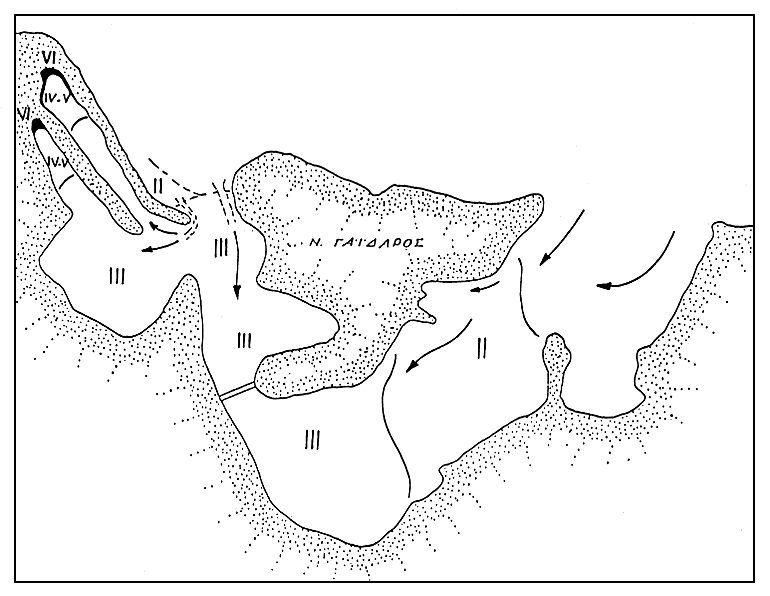
Fig. 11 Map of confinement zones in Kyparissi lagoonal area
These characteristics led to the following lagoonal management propositions (Fig. 12):
Extensive aquaculture in the central part of the basin. For this purpose the construction of fish traps and net barriers between the island of Gaidaros and the mainland are required (fish traps especially for mullets).
Semi-intensive aquaculture for clams (Ruditapes decussatus) which already exists in the natural environment) and shrimps (Peneidae) in enclosures in the northern part of the lagoon. This region of the lagoon is strongly suggested for such culture, because of:
very shallow waters (uncovered substratum at low tide)
proper muddy-sand
seawater enriched with high phytoplanktonic biomass
easy to handle and easily accessible
2. Almyros bay
This bay is deeper than Vourlia lagoon (depth 10–15 m). In the main part of the bay the sediment is thicker (gravels) and without accumulation of organic matter.
The main characteristic of this bay is the predominant influence of seawater. Only the last part of this bay has lagoonal characteristics (presence of Cymodocea nodosa seagrass and high phytoplanktonic biomass). It is thus proposed:
In the parts which are located closer to the sea, installation of floating cages for intensive aquaculture of seabream and seabass, because of the various advantages of this zone, such as:
high bathymetry
strong hydrodynamic activities of currents
constant quality of the water
wind-protected zone
In the other part of the bay (close to the coast) with lagoonal characteristics shellfish can be cultivated (mussels and flat oysters in suspension on rafts). The test with mussels gave very successful results in the first year.
In conclusion, this existing double system (Vourlia-Almyros) presents, with all their biogeological characteristics, a potential for many types of aquaculture.
All the aquaculture potentialities of this site are linked to the presence of the existing dam. The proposed management can become very beneficial for substantial biological production, because the existing dam confines the lagoon in two different sites and therefore increases the biological productivity.
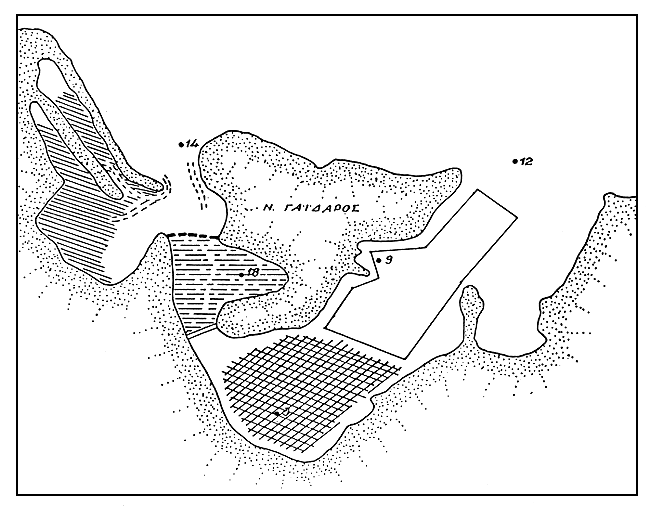 |  |
| Intensive aquaculture (floating cages) | |
 | |
| Shellfish culture | |
 | |
| Semintensive aquaculture (clams, shrimps) | |
 | |
| Extensive aquaculture (fish trapping) | |
 | |
| Fish traps and barriers |
Fig. 12 Propositions for aquaculture management of Kyparissi lagoonal area
CONCLUSION
In conclusion, in such a country as Greece where few coastal environments are well known and where the main lagoonal activities are fishing and extensive fish culture, the best way to develop lagoonal production is by keeping management to a minimum.
The semi-intensive culture activities which do not need high technological input or high financial investment are strongly suggested.
In the future it will be possible to make a second step toward intensive aquaculture activities which need high technology, and have a high cost of functioning and investment.